

WORDS: Technology and Theory in the Museum. When I first began work in the museum world, back in the twentieth century, the doors that marked the boundary between the public galleries and private spaces of my first museum in London had small embossed signs on them that declared, “This door to be kept closed, by order of the Director.”
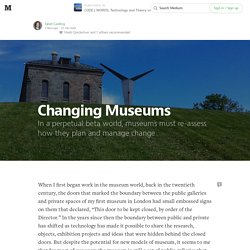
In the years since then the boundary between public and private has shifted as technology has made it possible to share the research, objects, exhibition projects and ideas that were hidden behind the closed doors. But despite the potential for new models of museum, it seems to me that for most of our users the museum is still a set of public galleries that occasionally change, and the rest remains a mystery. Why is it so hard to change how museums work? In the last twenty-five years we’ve seen the rhetoric of the “new museology”, the growth of audience research, and most significantly the disruption of all in its path by digital technologies.
How we have talked about strategy. Über das Sammeln in der Kulturwissenschaft. Art Museum Teaching Mashup – Cleveland. Do you want to try something fun while stepping outside of your comfort zone?
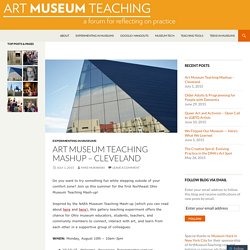
Join us this summer for the first Northeast Ohio Museum Teaching Mash-up! Inspired by the NAEA Museum Teaching Mash-up (which you can read about here and here), this gallery teaching experiment offers the chance for Ohio museum educators, students, teachers, and community members to connect, interact with art, and learn from each other in a supportive group of colleagues. WHEN: Monday, August 10th – 10am-3pm WHERE: Museum of Contemporary Art Cleveland, 11400 Euclid Avenue, Cleveland, OH 44106.
Wie das? Vom anonymen Museumsbesucher zur Partizipation - Teil 2 #KultDef. Neil MacGregor übernimmt Gründungsintendanz des Humboldtforums. Kultur und Wissensschätze Bayerns. Dear Arts: It’s Not Your Challenge Alone. Last week Createquity published an analysis looking at why people in lower socioeconomic status (SES) don’t attend arts events.
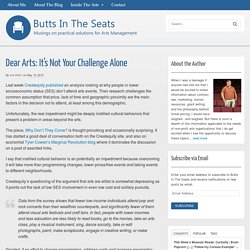
Their research challenges the common assumption that price, lack of time and geographic proximity are the main factors in the decision not to attend, at least among this demographic. Unfortunately, the real impediment might be deeply instilled cultural behaviors that present a problem in areas beyond the arts. The piece, Why Don’t They Come? Is thought provoking and occasionally surprising.
It has started a good deal of conversation both on the Createquity site, and also on economist Tyler Cowen’s Marginal Revolution blog where it dominates the discussion on a post of assorted links. Michelle Obama, “Activism”, and Museum Employment: Part I. Over the next few weeks, a handful of Incluseumers will reflect on and unify three topics that are usually treated as separate.
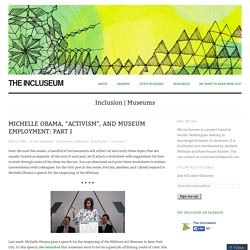
At the end of each post, we’ll attach a worksheet with suggestions for how to work through some of the ideas we discuss. You can download and print these worksheets to initiate conversations with colleagues. For the first post in this series, Porchia, Aletheia, and I (Rose) respond to Michelle Obama’s speech for the reopening of the Whitney. Last week, Michelle Obama gave a speech for the reopening of the Whitney Art Museum in New York City. Museum 2.0: How Do You Define "Community?" Close your eyes and imagine your organization's "community.
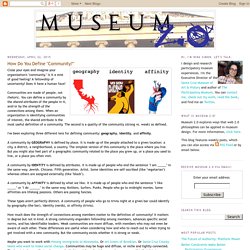
" Is it a mist of good feeling? A fellowship of uncertainty? Does it have a human face? Communities are made of people, not rhetoric. You can define a community by the shared attributes of the people in it, and/or by the strength of the connections among them. Group Tour Interest in Decline: Why Museums Should Invest Elsewhere (DATA) Investing in attracting tour groups is an increasingly futile endeavor for museums.
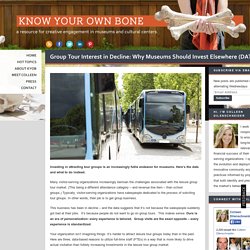
Here’s the data and what to do instead. Many visitor-serving organizations increasingly bemoan the challenges associated with the leisure group tour market. (This being a different attendance category – and revenue line item – than school groups.) Mass tourism forces mobbed museums to overhaul welcome. Paris (AFP) - Mass tourism spurred by cheap flights and richer emerging economies is forcing the world's top museums to rethink their welcome, notably by boosting access, embracing apps and improving ancillary services such as eateries and gift shops.
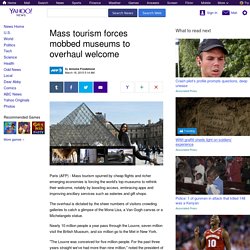
The overhaul is dictated by the sheer numbers of visitors crowding galleries to catch a glimpse of the Mona Lisa, a Van Gogh canvas or a Michelangelo statue. Nearly 10 million people a year pass through the Louvre, seven million visit the British Museum, and six million go to the Met in New York. Practical actions for museums. 1.
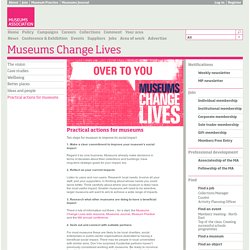
Make a clear commitment to improve your museum’s social impact Regard it as core business. DIY Leadership Development. Two steps nonprofits can take to develop up-and-coming leaders day-to-day.
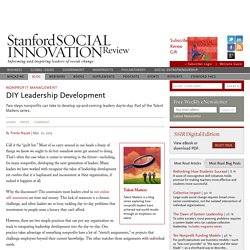
Part of the Talent Matters series. Talent Matters Talent Matters is a blog series exploring how nonprofit leaders have achieved real-world results through an emphasis on talent. Call it the “guilt list.” Most of us carry around in our heads a litany of things we know we ought to do but somehow never get around to doing. More on the Wacky World of Museum Economics. “Food should be more expensive.”
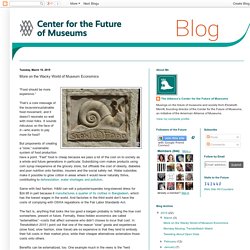
That’s a core message of the locavore/sustainable food movement, and it doesn’t resonate so well with most folks. It sounds ridiculous on the face of it—who wants to pay more for food? The museum as digital storyteller: Collaborative participatory creation of interactive digital experiences. Maria Roussou, American College of Greece / University of Athens / makebelieve design & consulting, Greece, Laia Pujol, Pompeu Fabra University, Spain, Akrivi Katifori, University of Athens, Department of Informatics and Telecommunications, Greece, Angeliki Chrysanthi, University of Southampton, UK, Sara Perry, University of York, UK, Maria Vayanou, National and Kapodistrian University of Athens, Greece Abstract Digital storytelling is one resource museums have in hand for enriching their offer to audiences and society at large.
But how is the museum to author digital storytelling experiences that cater to various needs while maintaining scientific integrity? In this paper, we report on a series of experiences involving the creation of several interactive rich-media museum stories. The Final Pieces Of The 9/11 Memorial Museum: Visitors, Their Stories, And Rooms That Listen. Like all museums, the 9/11 Memorial Museum will tell visitors a story. Unlike most places, however, rooms in this building will also listen to memories. Jake Barton, principal and founder of media-design firm Local Projects, is wrapping up an eight-year project as the exhibit designer for the 9/11 Memorial Museum, opening to the public next week.
Inside, visitors will be able to view and interact with 90 different exhibits that incorporate first-person experiences, oral histories, artifacts, and interactive pieces. They'll also be able to add their own stories to some of the exhibits. Most museum websites are terrible - Museum Marketing. What is the main aim of a museum website? Browsing the internet, you quickly conclude that this is to promote the institution to potential visitors. This is of course a worthwhile aim, museums would not exist without an audience, but I believe that museum websites can be much more. The starting point for all digital activities within a museum should be it’s mission, this is likely to be to educate, to inspire, to preserve and to share (or similar).
Inspiring Examples of Citizen Participation. Photo By: Howard Lake "As a citizen, you need to know how to be a part of it, how to express yourself - and not just by voting. " ~ Sandra Day O'Connor We all want more engaged communities. Whether that is for your business or in your town, fighting apathy is struggle that many of us face. All Our Suggestions. The traditional museum is a byproduct of previous generations.
In the best European traditions, they became the arbiters of our cultural heritage — the shrines to the objects and values that we as societies held dear. They held our collective memories and were expansive libraries of ideas and objects. The modern museum finds the past isn’t enough and is evolving in the face of a changing world. 20 Key Museum Concepts. Museums: The Permanent Collection Concept.